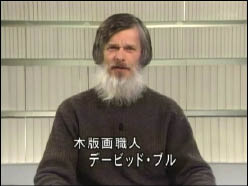Forgotten Beauty of Woodblock Prints (III)
In the previous issues, we had the first two episodes outlining possible content for a documentary that would give people a good overview of my work. In this third part, we learn that 'woodblock prints' and 'ukiyo-e' are far from synonymous ...
The Forgotten Beauty of Japanese Woodblock Prints
[Part Three - The Wider World of Japanese Prints]
[Camera] Dave is in his 'library'. Bookshelves and drawers fill our field of view. Dave sits at a low table, and over the course of the next few minutes, as he tells us about various types of woodblock prints, he pulls folders off the shelves and prints from the drawers to illustrate his discussion. By the time this segment is done, the table will be covered with the works that he has shown us.
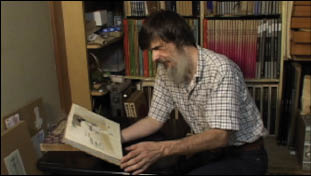 [David] "The idea of a foreigner becoming deeply involved with some aspect of Japanese culture is quite appealing to some Japanese people, so I get quite a lot of media attention - interviews and suchlike. And I have learned - by going through hundreds of interviews - that there are some misunderstandings about the world of Japanese prints that are very common. For example, even while we are looking at a modern print like this [Dave shows one of his recent prints - a landscape of his own design], the reporter may say, 'It's quite beautiful. How did you become interested in making Japanese ukiyo-e?'
[David] "The idea of a foreigner becoming deeply involved with some aspect of Japanese culture is quite appealing to some Japanese people, so I get quite a lot of media attention - interviews and suchlike. And I have learned - by going through hundreds of interviews - that there are some misunderstandings about the world of Japanese prints that are very common. For example, even while we are looking at a modern print like this [Dave shows one of his recent prints - a landscape of his own design], the reporter may say, 'It's quite beautiful. How did you become interested in making Japanese ukiyo-e?'
"It seems that to many people these days, the word 'ukiyo-e' equals 'Japanese prints'. It's easy to understand why; after all, everybody has heard so much about the famous prints of the Edo era: those by Hokusai, Hiroshige, Utamaro, etc. etc. Those were ukiyo-e, and they were prints. But the impression made by that work has been so dominating, so overwhelming, that people today have developed a kind of 'tunnel vision'.
"Back in the Edo period, ukiyo was a kind of philosophy of living, and as such, became expressed in the literature, poetry, and imagery of the day. One hugely important thing to remember though, is that the concept 'ukiyo-e' describes the content of those famous images, not the technology used to create them. Woodblock printing was used to create what we now know as ukiyo-e, simply because it was the only technology available at the time for mass publication.
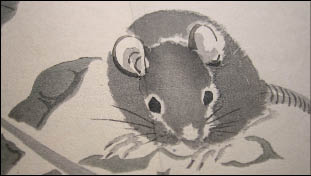 "But the world of Japanese prints is far wider than the world of ukiyo-e - it's wonderfully diverse! There are all kinds of hugely interesting prints to see, and even if our session together were to continue all day, I still wouldn't have time to show you all I would like to!"
"But the world of Japanese prints is far wider than the world of ukiyo-e - it's wonderfully diverse! There are all kinds of hugely interesting prints to see, and even if our session together were to continue all day, I still wouldn't have time to show you all I would like to!"
[Dave pulls out a folder from the shelf, and takes out a small book with yellow covers. He opens it to show us an image - a delicate painting of a small mouse and some plants.] "Here is a wonderful example of woodblock printing in the service of another art - watercolour painting. This is what is known as a te-hon, an 'example' book, and would have been used by people practicing their painting techniques.
"This particular volume is clean and well-preserved, but many such books are found with sketches and test brush strokes covering the pages; and we can easily imagine the scene as the 'sensei' demonstrated how a particular stroke should be made ...
"Looking through the book we can see how wonderfully the carvers and printers were able to reproduce the watercolour style: the dry brush strokes, the gradated 'washes' of colour, and especially the contrast between deep saturated colours and those so faint that they are barely visible. Yet this is a woodblock print!"
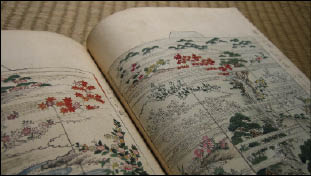 [Laying the book aside, Dave reaches back up to the bookcase, bringing down another book, this one larger and heavier than the first. When he shows us the inside, we see that it is full of images of traditional kimono.] "Staying with books for a minute, here is another item that leaves me speechless in amazement. It is a catalogue of kimono designs, sent by the manufacturer to kimono shops around the country so that potential customers could see the selection of fabrics available. The woodblock technique was perfectly suited to this work, as the tones and colours were capable of an exquisite level of subtlety, certainly equal to the task of expressing the nuances of a selection of kimono designs.
[Laying the book aside, Dave reaches back up to the bookcase, bringing down another book, this one larger and heavier than the first. When he shows us the inside, we see that it is full of images of traditional kimono.] "Staying with books for a minute, here is another item that leaves me speechless in amazement. It is a catalogue of kimono designs, sent by the manufacturer to kimono shops around the country so that potential customers could see the selection of fabrics available. The woodblock technique was perfectly suited to this work, as the tones and colours were capable of an exquisite level of subtlety, certainly equal to the task of expressing the nuances of a selection of kimono designs.
[Camera: We study a few pages of the volume, panning across images of various fabrics. There is an astonishing variety of patterns: floral designs, nature scenes, abstracts ... page after page of them ...]
[David: voice-over] "Producing a book like this must have been a tremendous job; many of the pages required a large number of colour blocks to be carved, and of course the printers must have made a large number of copies of each image in order that the catalogue could be distributed widely. But the woodblock technology is so efficient, that even a massive job like this could be done economically. And beautifully!"
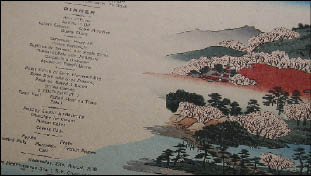 [Camera: Dave pulls a file from the shelf, opening it to show pages of images, that - at first glance - look like traditional ukiyo-e prints.] "This one is fun! We all know the story about how the ukiyo-e prints that we now prize as rare treasures, were of course nothing of the kind back in their own day. They were inexpensive articles of commerce. Well look at this - everything in this folder is a hand-made woodblock print, yet these too, were not only inexpensive, they were free!"
[Camera: Dave pulls a file from the shelf, opening it to show pages of images, that - at first glance - look like traditional ukiyo-e prints.] "This one is fun! We all know the story about how the ukiyo-e prints that we now prize as rare treasures, were of course nothing of the kind back in their own day. They were inexpensive articles of commerce. Well look at this - everything in this folder is a hand-made woodblock print, yet these too, were not only inexpensive, they were free!"
[The camera follows Dave's finger as he shows us details of one of the items ...] "Look at this one, based on a very old-fashioned design; it looks quite similar to the old Hiroshige prints ... these men poling rafts in the river. It's quite nicely carved and printed ... [his finger moves across the print] ... but what's this? 'Roast Sirloin of Beef with Horseradish. Roast Duck with Sage Dressing.' It's dated the 27th of August 1930, off the South-East coast of Spain. Yes, the Japanese ocean liners of the pre-war period - the NYK ships - thought that their foreign passengers would enjoy having their dinner menus produced with handmade woodblock prints, and I'm sure they were right!
"The prints were prepared on shore by a specialist company, and taken on board ship in huge stacks. There was a small printing press on board each ship, and once the chef had decided on the particular food to be served that evening, the lettering would be printed on top, and the menus placed on the tables."
"Using woodblock prints in daily life - I can show you many many examples of this. [Dave reaches up to the shelf again ...] Let's just take a quick glance at a few samples."
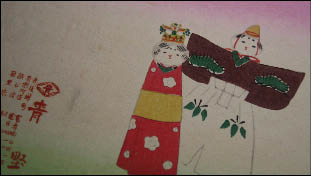 "Look at this one. [David shows us another item, a slip of paper with bright pink and green colours] This is an attractive little print, don't you think? But look at these slight creases here ... they tell us a story. And this stamp, which lists some telephone numbers. Yes, this is a piece of wrapping paper! It was once folded around the front of a box of sweets!
"Look at this one. [David shows us another item, a slip of paper with bright pink and green colours] This is an attractive little print, don't you think? But look at these slight creases here ... they tell us a story. And this stamp, which lists some telephone numbers. Yes, this is a piece of wrapping paper! It was once folded around the front of a box of sweets!
"Woodblock printing was once so pervasive in society that even such things as the wrappers for food packages were created this way. And look at how beautifully it was produced; the carving is delicate and the colours are deep and smooth. These wrappers must have been made in huge quantities, yet the men who made them went about their job with pride. They knew that the customers of this shop had 'eyes for quality', and they responded in kind."
[David pauses for a moment, looking over his shelves, trying to decide which of his treasures to show us next ...] "I think I should be careful; if I show you too many examples of the daily uses of woodblock prints in this society you would just get overloaded. There is so much! Letter paper pre-printed with woodblock patterns; these little envelopes for holding money for gifts; it just goes on and on ...
"Do you have the impression that all these 'daily life' woodblock prints are perhaps too trivial, and basically inconsequential? Do you think that items produced in such a 'mass' way are not worthy of our appreciation and study? Well if you do, then perhaps this will change your mind. [David pulls a small book from the shelf.] This is 'nothing special'. It's a magazine from the Meiji period; there was quite a boom in literary magazines in those days. By this time, printing presses had arrived in Japan, and the main body of these magazines was produced in that fashion. But it became common for such magazines to have a woodblock printed frontispiece folded into place, like this." [David unfolds the print that is bound into the magazine he is holding.]
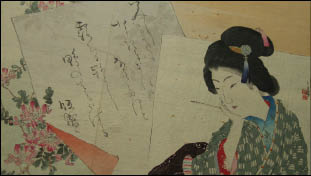 [David now shows us an album full of such prints] "These frontispieces generally illustrate episodes from the stories in the magazine. They were produced in huge quantities, and very quickly, with teams of printers working on each image scrambling to get it ready for the publication date. Get it done, get it out the door, and get busy on the next one.
[David now shows us an album full of such prints] "These frontispieces generally illustrate episodes from the stories in the magazine. They were produced in huge quantities, and very quickly, with teams of printers working on each image scrambling to get it ready for the publication date. Get it done, get it out the door, and get busy on the next one.
"Is there a nice zoom on that camera? Let's take a good look at this masterpiece! When we feel the paper, we find that it is thinner than tissue, yet strong enough to withstand the vigourous rubbing with the baren. Look at the transparency of the paper on which the writing is printed, with the flowers underneath showing through ... realize that this is an illusion this entire print is made from only a single sheet of paper. Study the 'brush strokes' - see how the ink progresses from heavier black at the top of each line, down to light grey at the bottom as the ink is drained from the brush ... but this is a flat print, made with a baren and a woodblock, not a calligraphy brush!
"Now, look over at the main image, the woman on the right. Your eyes will have to be a lot better than mine to be able to see unbelievable delicacy of the strands of hair brushed back from her forehead. As you move closer, notice the shiny shomen-zuri effect on the hair - the baren was used on the front of the print to create the gloss. Look at these delicate gradations everywhere on the print, here, here and here ... Can you see the nuno-zuri (cloth texture effect) background printed here? And look at these metallic powders sprinkled on her poem card ..."
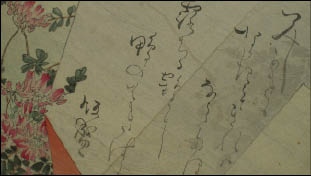 "If all this isn't enough to leave you breathless, please remember - this magnificent object was folded into the front of one of those magazines, simply as a cheap 'freebie' for the readers ... something to glance at and then toss aside ... It was completely disposable. Incredible."
"If all this isn't enough to leave you breathless, please remember - this magnificent object was folded into the front of one of those magazines, simply as a cheap 'freebie' for the readers ... something to glance at and then toss aside ... It was completely disposable. Incredible."
[David now speaks directly to us ...] "Many of the objects I have shown you do still exist in our current society, but are no longer made with the woodblock techniques. Even though the beauty of woodblock prints may be uncontested, there is no question that they are no longer cost-effective. At least not if you just look at the 'bottom line' of the bookkeeping ledger.
"Must we always strive for 'cheaper and faster' though? In some areas of society, I cannot complain about our worship of efficiency - after all, modern technologies have brought us full bellies and comfortable lives, something denied to most people in the 'good old days'. I do not want to go back there.
"It could be that our modern society has now begun a process of re-evaluating just what is important, and what is not. We hear about 'slow food', and of course, we have always had people encouraging us to 'stop and smell the flowers'. The fact that I have been able to make a living from producing woodblock prints for over two decades now tells me that there are indeed people out there who want to make these things part of their daily lives.
"Won't you join us?"
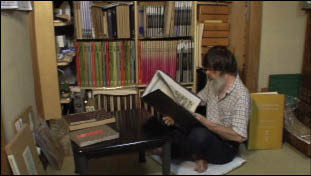
[David returns to the print folder on the table, and this segment closes as we join him in browsing some more of the Meiji frontispieces ...]
[End Part Three]
(in the next issue, we will begin the second half of the program, with Part Four)
 This season marks a particular milestone for my printmaking work. In early 1989 I was just at the very beginning of my long Hyakunin Isshu print series. I had finished the first couple of prints, but hadn't given too much thought as to exactly how to go about getting them out into the world.
This season marks a particular milestone for my printmaking work. In early 1989 I was just at the very beginning of my long Hyakunin Isshu print series. I had finished the first couple of prints, but hadn't given too much thought as to exactly how to go about getting them out into the world.


 [David] "The idea of a foreigner becoming deeply involved with some aspect of Japanese culture is quite appealing to some Japanese people, so I get quite a lot of media attention - interviews and suchlike. And I have learned - by going through hundreds of interviews - that there are some misunderstandings about the world of Japanese prints that are very common. For example, even while we are looking at a modern print like this [Dave shows one of his recent prints - a landscape of his own design], the reporter may say, 'It's quite beautiful. How did you become interested in making Japanese ukiyo-e?'
[David] "The idea of a foreigner becoming deeply involved with some aspect of Japanese culture is quite appealing to some Japanese people, so I get quite a lot of media attention - interviews and suchlike. And I have learned - by going through hundreds of interviews - that there are some misunderstandings about the world of Japanese prints that are very common. For example, even while we are looking at a modern print like this [Dave shows one of his recent prints - a landscape of his own design], the reporter may say, 'It's quite beautiful. How did you become interested in making Japanese ukiyo-e?' "But the world of Japanese prints is far wider than the world of ukiyo-e - it's wonderfully diverse! There are all kinds of hugely interesting prints to see, and even if our session together were to continue all day, I still wouldn't have time to show you all I would like to!"
"But the world of Japanese prints is far wider than the world of ukiyo-e - it's wonderfully diverse! There are all kinds of hugely interesting prints to see, and even if our session together were to continue all day, I still wouldn't have time to show you all I would like to!" [Laying the book aside, Dave reaches back up to the bookcase, bringing down another book, this one larger and heavier than the first. When he shows us the inside, we see that it is full of images of traditional kimono.] "Staying with books for a minute, here is another item that leaves me speechless in amazement. It is a catalogue of kimono designs, sent by the manufacturer to kimono shops around the country so that potential customers could see the selection of fabrics available. The woodblock technique was perfectly suited to this work, as the tones and colours were capable of an exquisite level of subtlety, certainly equal to the task of expressing the nuances of a selection of kimono designs.
[Laying the book aside, Dave reaches back up to the bookcase, bringing down another book, this one larger and heavier than the first. When he shows us the inside, we see that it is full of images of traditional kimono.] "Staying with books for a minute, here is another item that leaves me speechless in amazement. It is a catalogue of kimono designs, sent by the manufacturer to kimono shops around the country so that potential customers could see the selection of fabrics available. The woodblock technique was perfectly suited to this work, as the tones and colours were capable of an exquisite level of subtlety, certainly equal to the task of expressing the nuances of a selection of kimono designs. [Camera: Dave pulls a file from the shelf, opening it to show pages of images, that - at first glance - look like traditional ukiyo-e prints.] "This one is fun! We all know the story about how the ukiyo-e prints that we now prize as rare treasures, were of course nothing of the kind back in their own day. They were inexpensive articles of commerce. Well look at this - everything in this folder is a hand-made woodblock print, yet these too, were not only inexpensive, they were free!"
[Camera: Dave pulls a file from the shelf, opening it to show pages of images, that - at first glance - look like traditional ukiyo-e prints.] "This one is fun! We all know the story about how the ukiyo-e prints that we now prize as rare treasures, were of course nothing of the kind back in their own day. They were inexpensive articles of commerce. Well look at this - everything in this folder is a hand-made woodblock print, yet these too, were not only inexpensive, they were free!" "Look at this one. [David shows us another item, a slip of paper with bright pink and green colours] This is an attractive little print, don't you think? But look at these slight creases here ... they tell us a story. And this stamp, which lists some telephone numbers. Yes, this is a piece of wrapping paper! It was once folded around the front of a box of sweets!
"Look at this one. [David shows us another item, a slip of paper with bright pink and green colours] This is an attractive little print, don't you think? But look at these slight creases here ... they tell us a story. And this stamp, which lists some telephone numbers. Yes, this is a piece of wrapping paper! It was once folded around the front of a box of sweets! [David now shows us an album full of such prints] "These frontispieces generally illustrate episodes from the stories in the magazine. They were produced in huge quantities, and very quickly, with teams of printers working on each image scrambling to get it ready for the publication date. Get it done, get it out the door, and get busy on the next one.
[David now shows us an album full of such prints] "These frontispieces generally illustrate episodes from the stories in the magazine. They were produced in huge quantities, and very quickly, with teams of printers working on each image scrambling to get it ready for the publication date. Get it done, get it out the door, and get busy on the next one. "If all this isn't enough to leave you breathless, please remember - this magnificent object was folded into the front of one of those magazines, simply as a cheap 'freebie' for the readers ... something to glance at and then toss aside ... It was completely disposable. Incredible."
"If all this isn't enough to leave you breathless, please remember - this magnificent object was folded into the front of one of those magazines, simply as a cheap 'freebie' for the readers ... something to glance at and then toss aside ... It was completely disposable. Incredible."

 The Japan Times, June 2008
The Japan Times, June 2008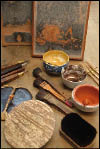 'Nikkei BPnet', September 2008
'Nikkei BPnet', September 2008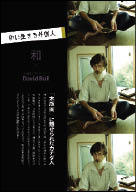 Every time I get a media request, I'm eager to hear what kind of interesting offer it is going to be. On this occasion, it was a magazine devoted to using Japanese traditions in our daily life. Now I certainly have nothing against that idea, as you know, but it did certainly feel a bit strange to flip through the resulting magazine issue: Dave in his blue jeans on one page, and young men modelling the 'latest' in kimono fashion on the next!
Every time I get a media request, I'm eager to hear what kind of interesting offer it is going to be. On this occasion, it was a magazine devoted to using Japanese traditions in our daily life. Now I certainly have nothing against that idea, as you know, but it did certainly feel a bit strange to flip through the resulting magazine issue: Dave in his blue jeans on one page, and young men modelling the 'latest' in kimono fashion on the next!